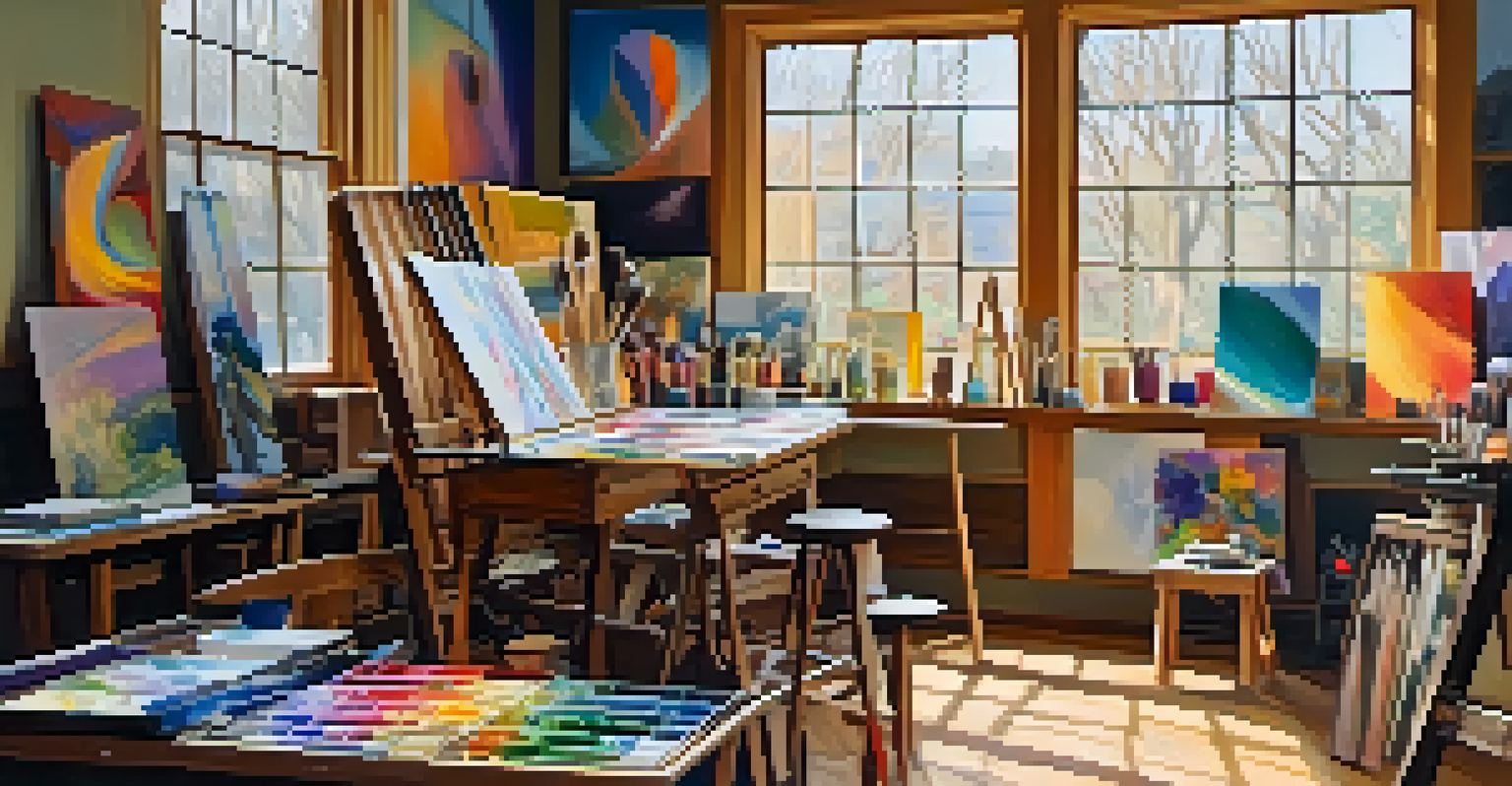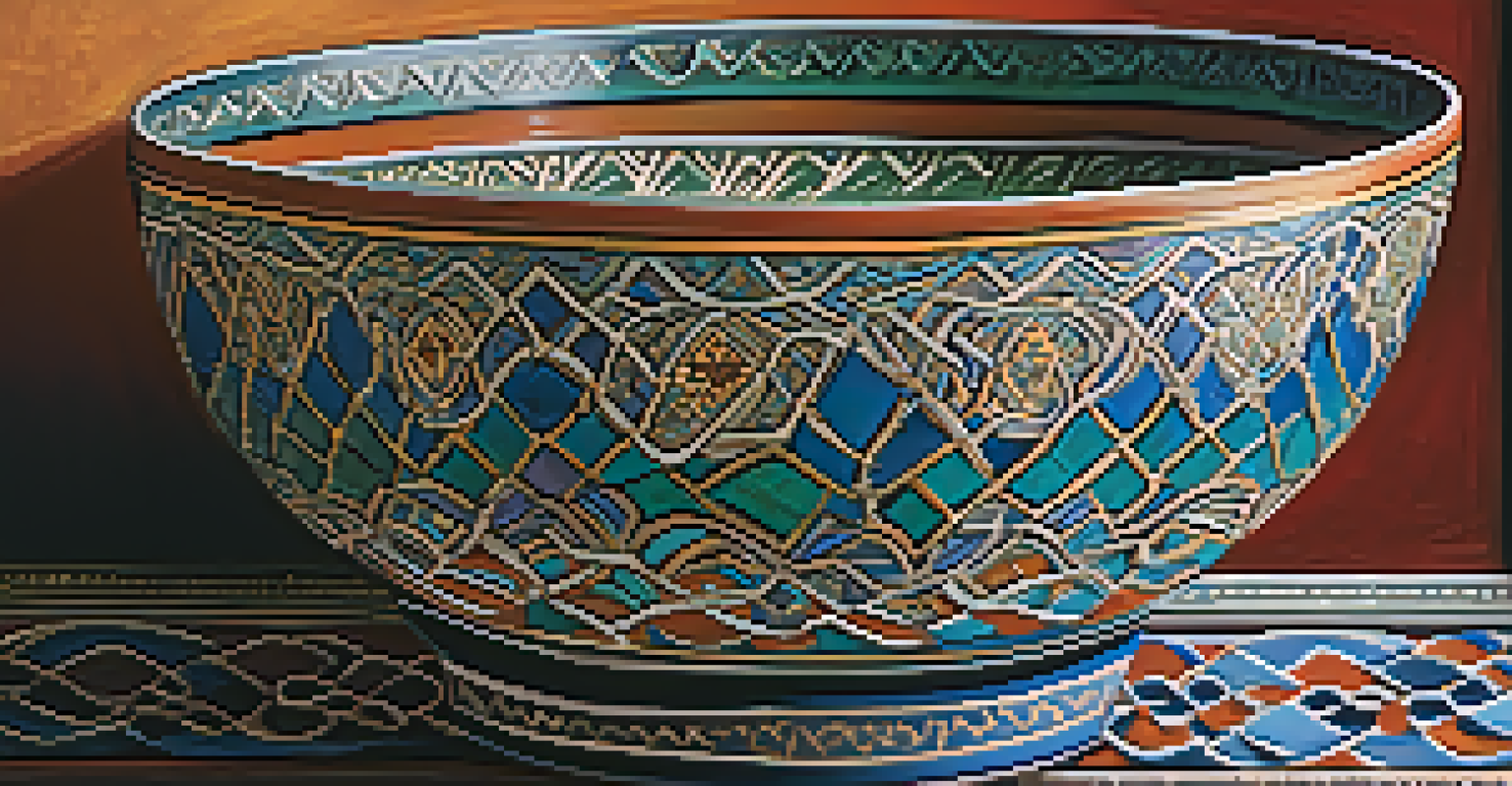Art and Religion: How Spirituality Shapes Cultural Expression

The Deep Connection Between Art and Spiritual Beliefs
Art and religion have long shared a profound relationship, often intertwining in many cultures. From ancient sculptures to modern paintings, artistic expressions have served as a visual language for spiritual beliefs. This connection is not just historical; it continues to resonate in contemporary works, reflecting the evolving nature of spirituality.
Art is the most beautiful of all lies.
For instance, many indigenous cultures use art as a means to convey their spiritual stories and beliefs. These creations often depict deities, myths, and natural elements, emphasizing the relationship between the physical and spiritual worlds. This illustrates how art can be a conduit for expressing the intangible aspects of faith.
Moreover, this interplay can lead to a deeper understanding of cultural identity, as art becomes a vessel for shared beliefs. By exploring these connections, we can appreciate how spirituality shapes not only individual expression but also collective narratives through art.
Historical Perspectives: Art as a Medium for Faith
Throughout history, art has played a pivotal role in religious expressions. From the majestic cathedrals of Europe adorned with stained glass to the intricate mandalas of Buddhism, these artworks serve as reflections of spiritual devotion. They often communicate complex theological concepts in visually engaging ways, making spirituality accessible to a broader audience.

Consider the Renaissance period, where artists like Michelangelo and Raphael infused their works with religious themes, illustrating biblical stories in an engaging manner. This not only elevated the status of artists but also helped patrons convey their piety and devotion through grand artworks. These masterpieces became a means of connecting the divine with the earthly.
Art Reflects Spiritual Beliefs
Art has historically served as a visual language for expressing spiritual beliefs across cultures.
Thus, examining historical contexts reveals how art has functioned as a bridge between humanity and the divine. It highlights the importance of cultural narratives that have shaped societal values and beliefs over centuries.
The Role of Symbolism in Religious Art
Symbolism is a crucial element in the relationship between art and religion, allowing artists to convey deeper meanings. Various symbols, like the lotus flower in Hinduism or the cross in Christianity, encapsulate complex spiritual ideas, making them accessible through visual representation. These symbols often transcend language, creating a universal understanding of faith.
The painter tries to master color and form to express the inexpressible.
For example, in Islamic art, geometric patterns and calligraphy serve as expressions of divine order and beauty, steering clear of figurative representation. This approach not only respects religious tenets but also demonstrates how creativity can thrive within specific constraints. It reflects a unique interpretation of spirituality through art.
In essence, symbolism enriches the viewer's experience and invites contemplation, allowing for personal interpretations of spiritual concepts. This highlights how art can serve as both a personal and communal exploration of faith.
Modern Art Movements and Spiritual Exploration
In recent decades, modern art movements have embraced spirituality in diverse ways, often questioning traditional forms. Artists like Mark Rothko and Wassily Kandinsky sought to express the ineffable through abstraction, inviting viewers to experience spirituality beyond literal interpretations. Their work often evokes emotional responses that resonate on a spiritual level.
Additionally, contemporary installations and performance art often incorporate religious themes, encouraging audiences to engage with spirituality in innovative manners. These forms can challenge conventional views on faith, prompting discussions about the relevance of spirituality in today's society. Through this lens, art becomes a platform for dialogue and exploration.
Symbolism Deepens Spiritual Connection
Symbolism in religious art allows for deeper meanings and universal understanding of faith.
Thus, modern art reflects a more pluralistic approach to spirituality, allowing for a broader range of interpretations and experiences. This evolution showcases how art continues to adapt and thrive in a world where spiritual beliefs are as varied as the artists themselves.
Art as a Tool for Social Change and Spiritual Awakening
Art has often served as a powerful tool for social change, particularly when intertwined with spirituality. Many artists use their work to address social justice issues, drawing on spiritual beliefs to inspire transformation. This approach not only raises awareness but also fosters a sense of community and shared purpose.
For instance, movements like the Harlem Renaissance showcased how art and spirituality intersected to advocate for civil rights and cultural pride. Artists like Jacob Lawrence and Aaron Douglas infused their works with spiritual themes, reflecting the struggles and triumphs of the African American experience. Their art became a rallying cry for equality and justice.
Ultimately, this demonstrates that art can transcend mere aesthetics, serving as a catalyst for spiritual awakening and social engagement. It highlights the responsibility of artists to use their platforms for meaningful dialogue and action.
Cultural Rituals and Artistic Expression
Cultural rituals often involve artistic elements that express and reinforce spiritual beliefs. From traditional dance to ceremonial music, these practices are steeped in symbolism and meaning, creating a rich tapestry of cultural identity. This artistic expression not only honors the divine but also strengthens community bonds.
For example, the use of masks in African tribal rituals serves both aesthetic and spiritual purposes. These masks often represent ancestral spirits, allowing participants to connect with their heritage and invoke protection or guidance. This fusion of art and ritual underscores the importance of creativity in cultural practices.
Modern Art Explores Spirituality
Contemporary art movements challenge traditional forms, inviting innovative spiritual expressions.
By participating in these artistic rituals, communities can collectively express their spirituality, fostering a sense of belonging and continuity. This highlights how art is not just a solitary pursuit but a shared experience that nourishes the spirit.
The Future of Art and Spirituality: Trends to Watch
As we look to the future, the relationship between art and spirituality continues to evolve, reflecting changes in society. Emerging technologies, like virtual reality and digital art, are creating new avenues for spiritual expression. Artists are exploring these mediums to engage audiences in immersive experiences that challenge traditional boundaries.
Moreover, the increasing interest in mindfulness and wellness is influencing how art is perceived and created. Many artists are incorporating themes of healing and self-discovery into their work, inviting viewers to reflect on their own spiritual journeys. This trend emphasizes the role of art in fostering personal growth and emotional well-being.

In conclusion, the future of art and spirituality holds exciting possibilities, as artists continue to push boundaries and explore new forms. This evolving landscape invites us to engage with spirituality in fresh and meaningful ways, ensuring that the dialogue between art and religion remains vibrant and relevant.